Perfect PETG bridges - 14.04.2024
PETG is a nice material for robust mechanical parts, it's easy to print, does not require a heated enclosure, does not smell, and still produces strong parts with that deform plastically rather than shatter immediately. Plus it last quite some time exposed to the elements outside. However, it also hardly shrinks when cooling. This means unlike ABS or PLA, where bridges tend to tension themselves while cooling, in PETG your saggy bridges will stay saggy. There has been a well known technique for a couple of years now, using PLA as support on PETG 3D-prints, to work around this. It makes sense because the two won't stick to each other, so you can just spam supports almost everywhere, and they'll peel off nicely.
The downside to this is you'll need a fancy printer, with at least dual material capabilities. I don't have one of those. On the other hand I really like my Chaos Inkl. Printer. It's a modified MendelMax 1.5, we build about 20 of them, so I know all the quirks. Over the last 10 years I spent a lot of time fixing and improving it. It's still working fine for me.

Recently I needed to print some din rail adapters for a (yet undisclosed) project at the HAM Radio Research Group. The slot for the mounting tap requires some long bridges. Usually I'd just use support for the long bridges, and clean them up with a file, or flip the part upside down and use my hot air station to melt them in place.
Unfortunately in this case, that won't work.
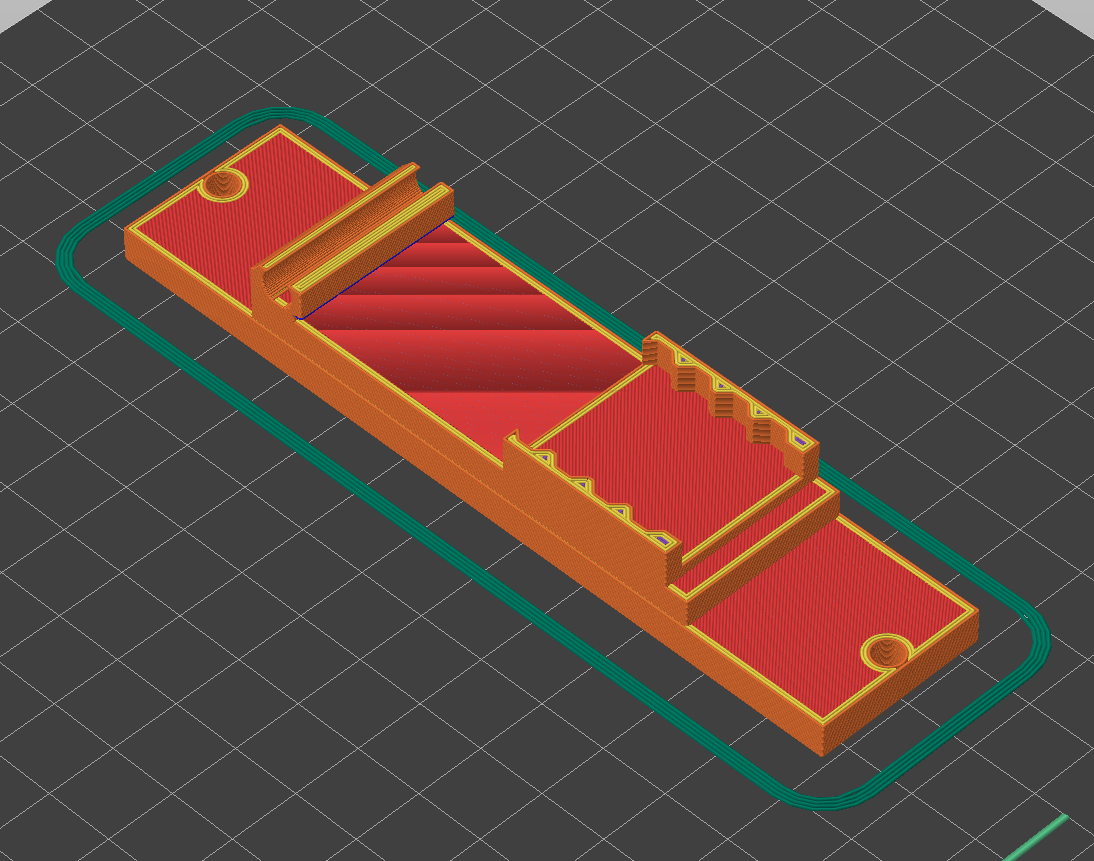
There is some internal geometry inside that slot, that would make the support material a real pain to remove.
However, due to the nature of the part, it should be possible to print right up to the layer where the bridges start, pause the print and add some form spacer, before printing the bridges. After the print is done, the spacer can be pulled out. That is unless it fuses with the print.
I modelled a simple part with similar dimensions (minus 0.2mm here and there for tolerance) to the tab, directly in PrusaSlicer.
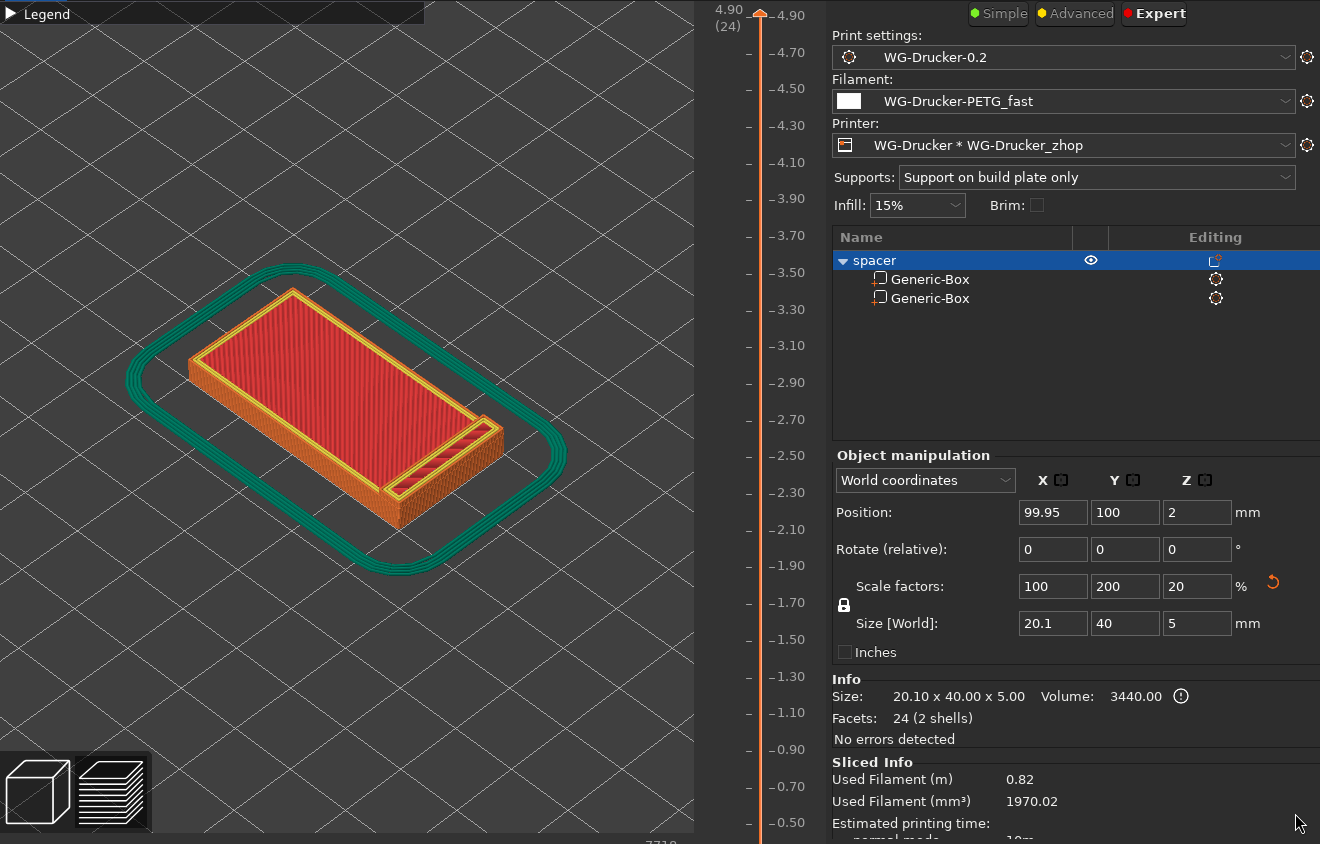
So the initial idea was to print in PLA for that. That involves switching filament, and since I mostly print PETG, thoroughly cleaning the nozzle to avoid clogging. It would be a lot more convenient to print the spacer in PETG and add some surface treatment, to prevent it from fusing with the bridges. After rummaging around the workbench if found a roll of Koptan(sic!) tape, that should be sufficiently non-stick and heat-resistant.

That only leaves the issue io pausing the print at exactly the right layer.
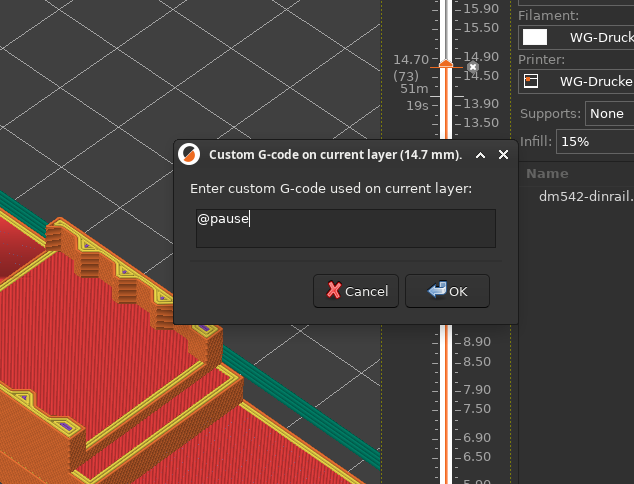
In my case that was simple since I'm using OctoPrint.
Scroll the layer marker thingy up to the layer just before the bridges start,
and right-click the hexagon next to it.
Chose custom g-code and simply enter @pause.
Since the @command is interpreted by OctoPrint, it should work pretty much regardless of the printer.
(That is provided you set the necessary gcode scripts.)
Once the printer has paused, the spacer can be put into place and resume the job.

Unless you hit the tolerances exactly right, the first layer on the tape will look weird.
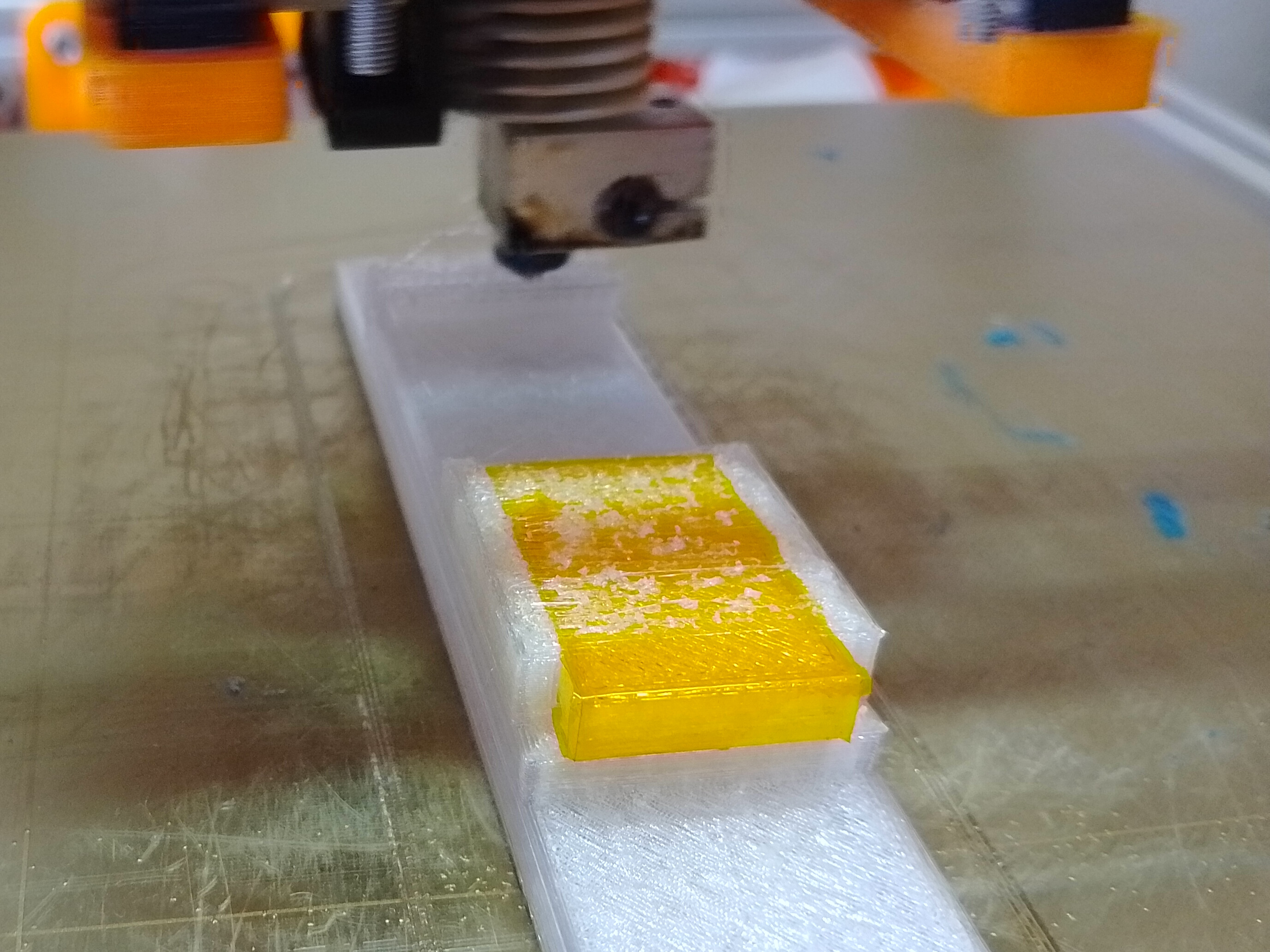
The next few layers will look a lot better.
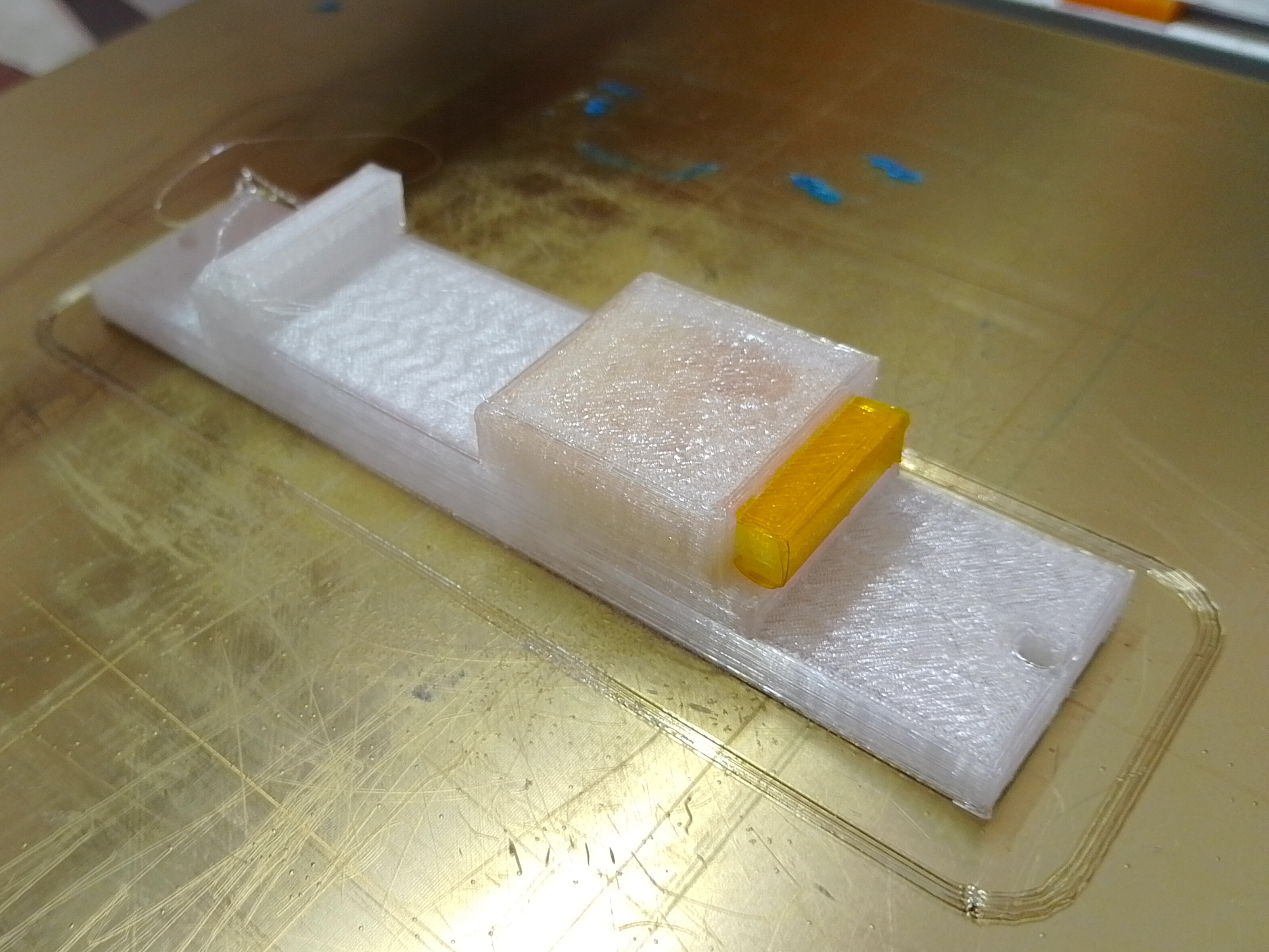
Once the print has finished the spacer can be pushed out with a screwdriver. Depending on the tolerances it might require a few gentle taps with a hammer.
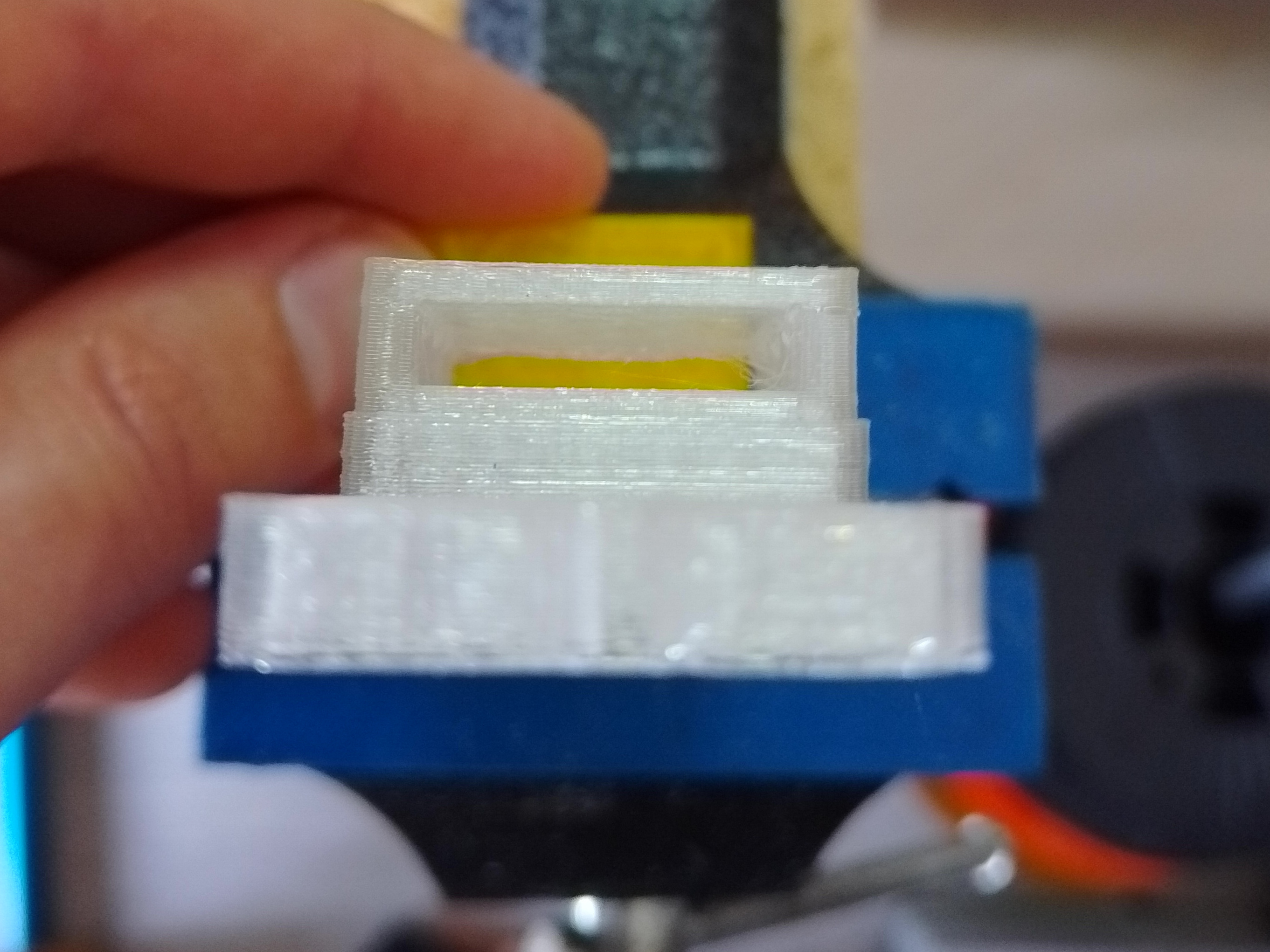
Unfortunately the inside top surface is hard to photograph, but by the power of printing spares and breaking one of them, we can get a better look.
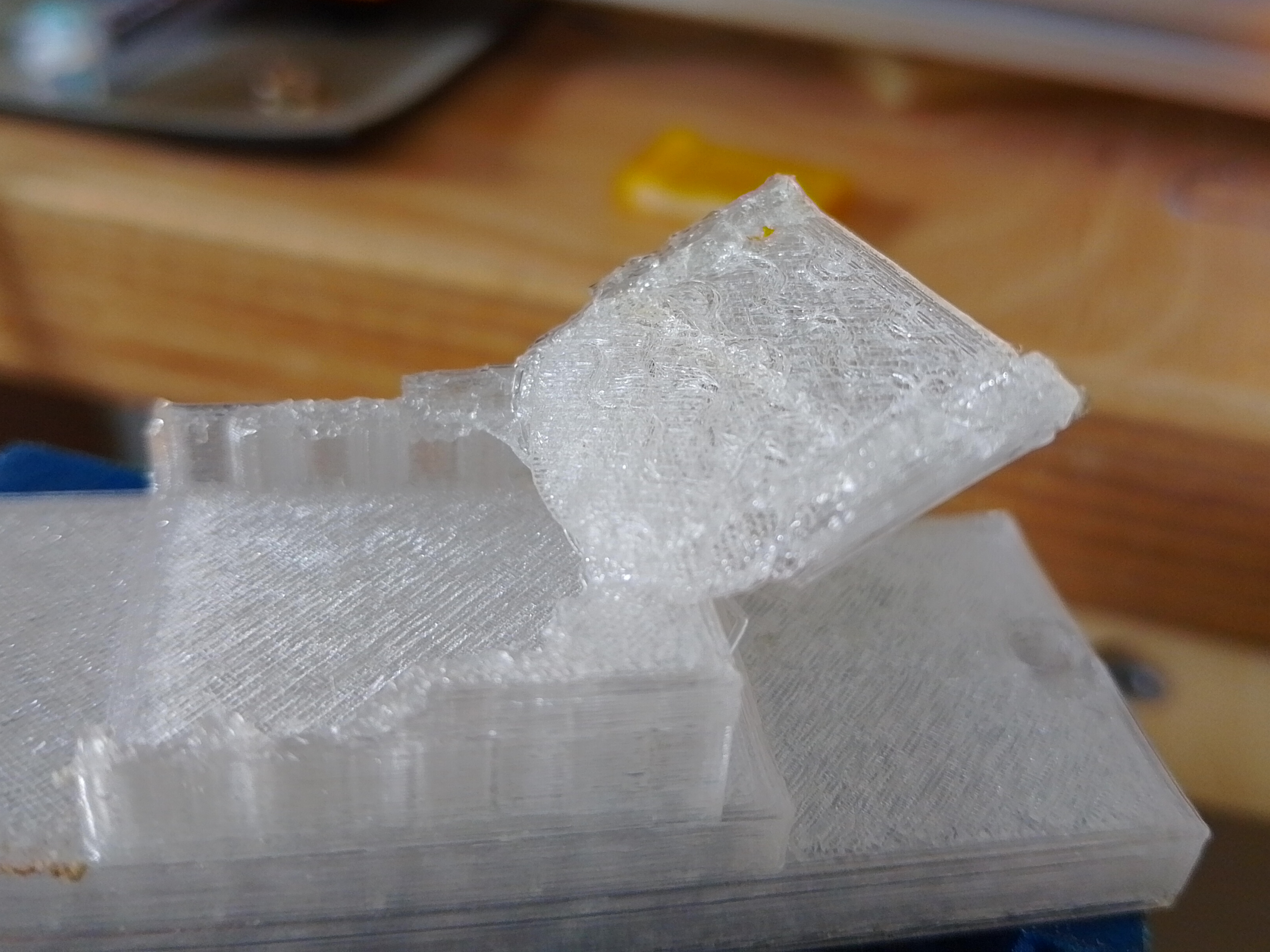
The part surface is almost as smooth as something printed directly on the bed. On my personal scale, that's pretty much perfect for a PETG part.
Of course this won't work for all shapes. If the spacer can not be pulled or pushed out due to its shape, or if there is not enough clearance to pull it out, you still have a problem. However, for those shapes you'd probably want water-soluble supports anyway, because it would be hard to remove supports mechanically (unless you have access to more than 3 dimensions in your workshop).
Other than this trick should give you very clean bridges in PETG even on an older machine.
Published: 14.04.2024 15:00 Updated: 15.04.2024 11:05PC-Wahl und ich - 07.09.2017
Anfang des Jahres gab es einen Aufruf des CCC, man möge ihnen doch Wahlsoftware als Sample zukommen lassen. Also hatte ich kurz darauf einfach eine Person, die bei der letzten Bundestagswahl Wahlhelfer war gefragt ob es denn da noch Sicherheitskopie auf USB-Sticks gäbe. Meine Vorstellung von so einer computergestützten Wahl auf einem kleinen Dorf, war halt eher wie eine LAN-Party, die meine Schulfreunde und ich früher immer organisiert hatten: Irgendein Zimmer im Gemeindehaus, viele private Computer und ein USB-Stick wird herumgereicht.
Unglücklicherweise ist der USB-Stick in der Zwischenzeit formatiert worden. Aber an ansonsten war ich damit leider näher an der Wahrheit als mir lieb war.
Mir wurde erklärt das bei mir Dorf und in ganz RLP die Software PCWahl eingesetzt wird. Ich googelte kurz, witzelte auf Twitter und schrieb eine zusammenfassende E-Mail an die Leute beim CCC. Das war am 18.2.2017. Danach hatte ich das ganze in Ermangelung eines zerforschbaren Samples schnell vergessen.
Fast forward 6 Monate.
Heute morgen wache ich auf und mein Twitter ist voller #pcwahl. Anscheinend haben die richtigen Leute ein Sample bekommen. Die komplette Analyse liest sich ziemlich gruselig und ich habe da eigentlich nichts hinzu zu fügen.
Aber ich will hier trotzdem noch mal den relevanten Abschnitt aus der E-Mail vom 18.2 wiedergeben, einfach nur um zu zeigen, dass nicht nur die Software sondern auch die Prozesse um die Software herum furchtbar kaputt sind. Natürlich ist das hier alles nur aus dritter Hand und basiert nur auf den Erinnerungen einer Person, aber ich glaube das generelle Problem ist trotzdem erkennbar.
Die Mail
Die einzelnen Wahlkreise erhalten je einen Auszählcomputer mit vorinstalliertem Windowsbetriebssystem und einen USB-Stick mit Software von dem Wahlleiter der Verbandsgemeinde. Die PCs werden wohl von einem IT Dienstleister für das ganze Bundesland mit Windows vorprovisioniert. Die Hardware ist, nach dem was mir berichtet wurde, nicht versiegelt oder sonstig gegen physische Manipulation geschützt. Zumindest erinnert die Person mit der ich geredet habe sich nicht an einen Prüfschritt. Im Wahllokal wird der PC in Betrieb genommen und die Software vom USB-Stick wird installiert. in dem Hardware geprüft wurde.
Bis zum Wahltag lagert die Hardware bei der Verbandsgemeindeverwaltung. Wahlhelfer die Wahlkreise holen die Hardware am Tag dort ab. Nach der Installation wird eine Prüfsumme angezeigt, die per Telefon abgeglichen wird. Eine Prüfung der Integrität der Windows-Installation im Wahllokal findet nicht statt. (Wie sollen Wahlhelfer das auch leisten...)
Bei der Auszählung werden die Wahlzettel in die Software übertragen und anschließend mit einer von der Software erzeugten ID versehen. Damit soll sichergestellt werden dass jeder Datensatz einem Wahlzettel zuordenbar ist. Am Ende zeigt die Software ein Ergebnis der Auszählung an. Dieses wird per Hand auf einen Vordruck übertragen und per Telefon dem Wahlleiter der Verbandsgemeinde mitgeteilt. Eine vollständige händische Überprüfung des Gesamtergebnisses findet wegen dem damit verbundenen Aufwand nicht statt. Besonders bei Wahlen bei denen man kumulieren und panaschieren kann, ist man wohl ziemlich vollständig auf die Software angewiesen. Es werden nur einzelne Stimmzettel stichprobenartig mit den Datensätzen verglichen. Danach werden die PC Hardware, ein USB-Stick mit der Datenbank der Auszählsoftware so wie alle Wahlzettel und der Vordruck mit dem Ergebnis von den Wahlhelfern zum Wahlleiter der Verbandsgemeinde transportiert. Die Datenbankdateien sind wohl "mit Prüfsummen" "gegen Manipulation geschützt". Allerdings existiert kein Weg diese mit einer anderen Software als PCWahl zu prüfen.
Wie die Ergebnisse auf der nächsten Ebene weiter kommuniziert werden ist mir nicht bekannt. Über den Ursprung der USB-Sticks mit den vorkonfigurierten Softwareinstallern habe ich ebenfalls keine Informationen.
Immerhin wird der Auszählcomputer (in dieser Verbandsgemeinde) wohl nicht mit dem Internet verbunden, auch wenn PCWahl Synchronisations-Funktionen über FTP(!) bereitstellt.
Was nun?
Fakt ist: Die Software wird sich nicht bis zur Wahl fixen lassen.
Also wenn ihr Wahlhelfer im Bekanntenkreis habt redet mit denen über die Software.
Die sollten erstens der Software nicht blind vertrauen und zweitens auch aufpassen wer wie mit dem Computer interagiert.
Zum Beispiel sollte jeder der versucht irgendwelche unbekannten USB-Sticks in den Computer zu stecken sofort eins auf die Finger bekommen.
Und bis zur nächsten Wahl brauchen wir eine sinnvolle sichere Software und ordentliche Policies um auch Lücken zwischen Bildschirm und zu schließen.
Cheatsheets - 10.02.2011
Cheatsheets für die Klausuren Grundlagen der Elektrotechnik 1 und 2 and der TU-Kaiserslautern.
Für aktualisierte Fassung in denen ein paar Tippfehler korregiert wurden, wollt ihr vielleicht mal in der Fachschat EIT vorbeischauen. Und wenn ihr eh da seid, grüßt die einfach mal von mir.
Published: 10.02.2011 15:14